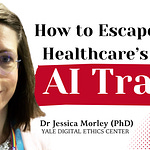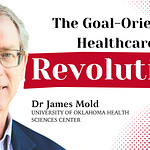"We want a two-way flow of communication so that we have a better understanding through the levels of an organisation up through those levels of what's actually happening and we can make decisions closer to the ground."
— Dr. Sharen Paine
Listen now on Apple, Spotify, YouTube or wherever you get your podcasts.
In this episode of Clinical Changemakers, Dr Sharen Paine, a systems thinking expert with a doctorate in business administration focusing on cybernetics, explores why healthcare organisations repeatedly struggle with the same problems despite constant restructures. Drawing from her hands-on work with ophthalmology services, Dr Paine introduces the Viable System Model (VSM) as a framework for creating truly functional healthcare organisations that can adapt and thrive rather than merely survive.
Key Takeaways
Cybernetics vs. Command-and-Control: Healthcare systems fail because they rely on one-way, top-down commands rather than cybernetic feedback loops. True organisational health requires continuous information flow between all levels, like an aircraft's autopilot system that constantly adjusts based on environmental feedback, not rigid directives from a distant control tower.
The Black Hole of Management Chaos: Service managers and clinical directors get consumed by day-to-day firefighting because healthcare systems lack proper coordination functions. Without clear coordination mechanisms, everything collapses into the management layer, creating a "tumble dryer" of urgent tasks that prevents strategic thinking and long-term planning.
The Five Functions of Viable Systems: Every healthcare organisation needs five continuously operating subsystems: (1) Operations that deliver patient care, (2) Coordination that orchestrates daily activities, (3) Management that sets conditions for success, (4) Intelligence/Planning that looks ahead strategically, and (5) Governance that defines purpose and values. Most healthcare systems conflate these functions, leading to dysfunction.
Recursive Autonomy Creates Efficiency: The VSM applies at every level—from national health systems down to individual departments. Each level requires all five functions to operate with appropriate autonomy. A $150 equipment purchase shouldn't require Wellington approval, just as an ophthalmology clinic shouldn't decide national hospital placement. Right-sized autonomy eliminates bureaucratic bottlenecks.
Coordination is the Missing Function: Healthcare systems fail to recognise coordination as a distinct, critical function requiring dedicated resources and IT systems. Coordination includes prioritised wait lists, rosters, schedules, skills matrices, and training—currently done manually or through spreadsheets, creating errors and inefficiency. Proper coordination would prevent most day-to-day chaos.
Where to Find Our Guest
Dr. Sharen Paine (LinkedIn)
In This Episode
00:00 - Introduction: Dr. Sharen Paine's background in cybernetics and systems thinking
07:37 - Sharen's journey: From mental health services to ophthalmology system challenges
15:05 - Production planning struggles: Why system changes fail without organizational support
18:16 - The governance-management-operations disconnect in healthcare hierarchies
25:04 - Introduction to the Viable System Model: Five essential organizational functions
26:59 - Defining viability: How organizations persist and adapt over time
28:05 - The five subsystems explained: From governance to operations
36:05 - Applying VSM to ophthalmology: What it looks like in practice
46:33 - Functions vs. roles: VSM describes what needs to happen, not organization charts
55:29 - Building collaborative understanding: Clinicians learning constraints, managers understanding frontlines
59:48 - Bottom-up implementation: Practical steps toward VSM adoption
1:05:12 - The VSM perspective: Seeing cybernetic patterns everywhere
Referenced
Utilising insights from cybernetics and the Viable System Model to address health system disconnects (Doctoral Thesis)
Principles for embedding learning and adaptation into the New Zealand health system functioning: the example of the Viable System Model (paper)
Utilising VSM insights to address health system disconnects: introducing three novel organisational pathologies (paper)
Mapping clinical governance to practitioner roles and responsibilities (paper)
Contact
If you have any feedback, questions or if you'd like to get in touch, reach out at jono@clinicalchangemakers.com
Music Attribution: Music by AudioCoffee from Pixabay.
Before you go! 🙌
As a small independent podcast, every rating and share makes a real difference in helping us reach more healthcare leaders. If you found value here, please rate us and pass this along to a colleague who needs to hear it.
Clinical Changemakers is a podcast that explores inspiring stories of leadership and innovation in healthcare. To learn more and join the conversation, visit: www.clinicalchangemakers.com










